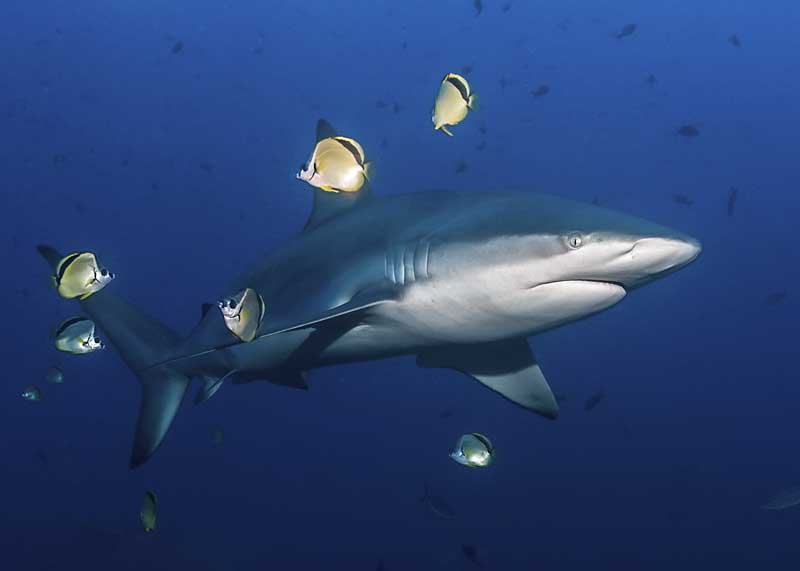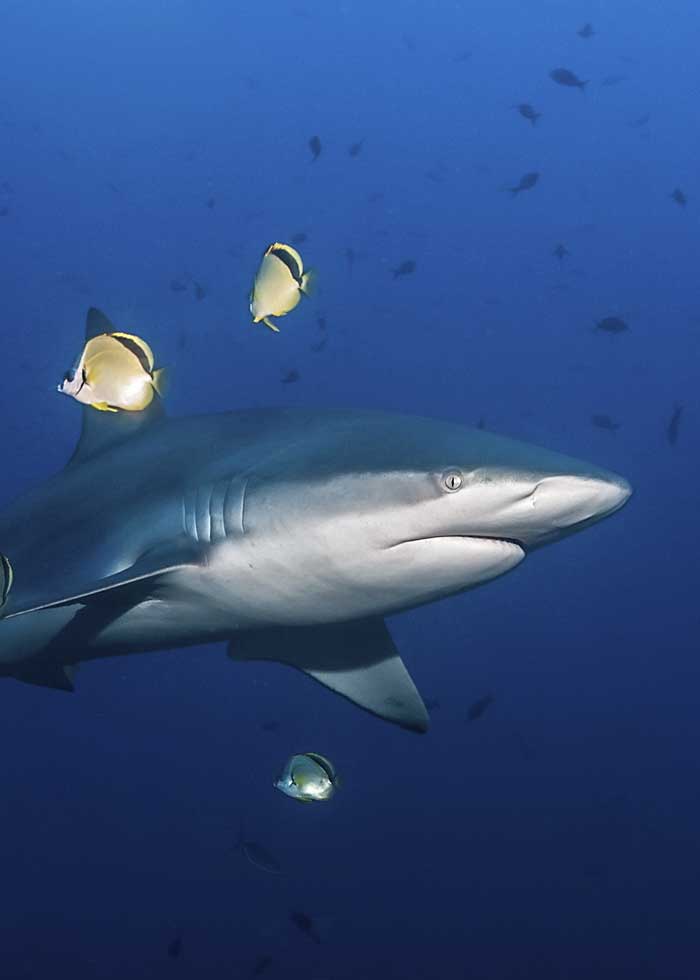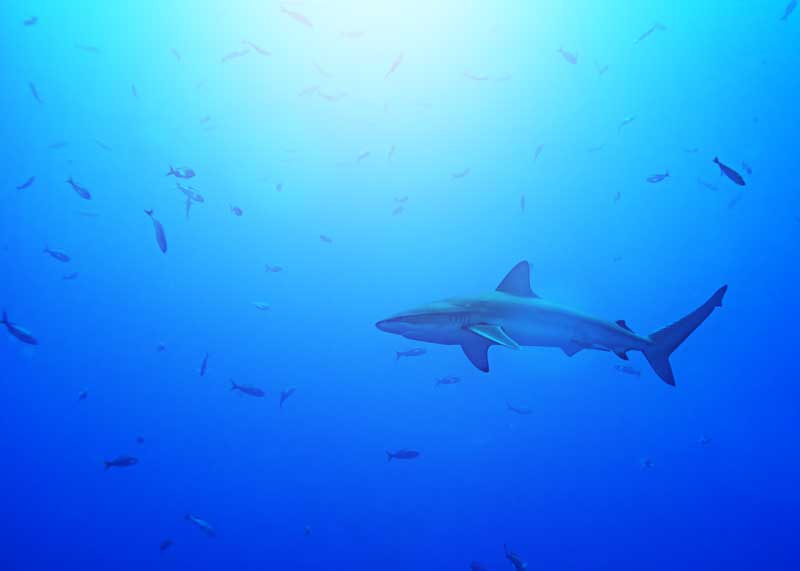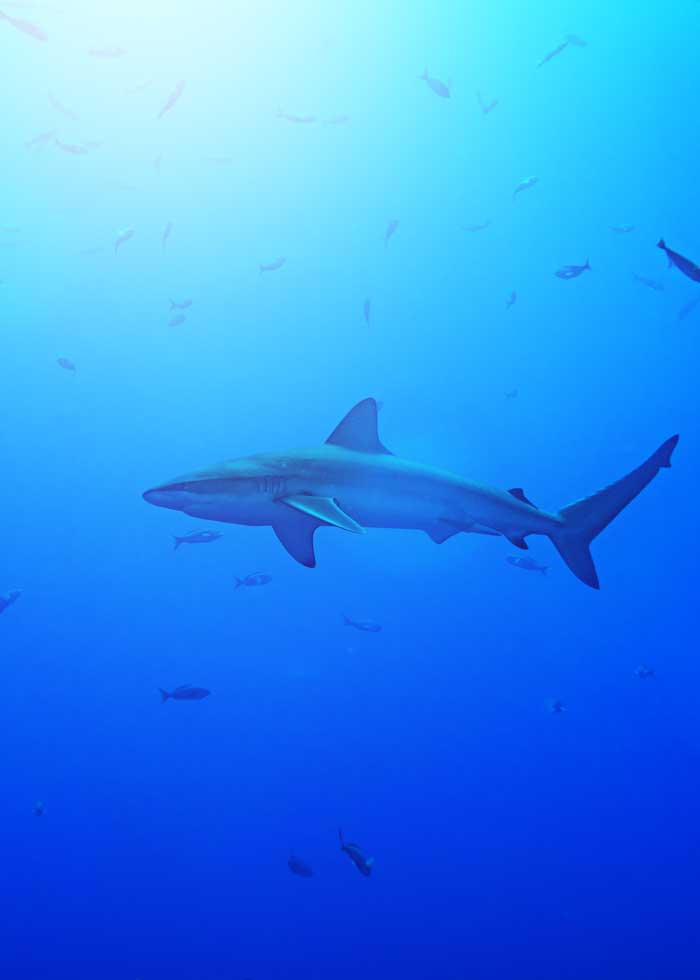17 Galapagos Shark Facts (Diet, Size, Attacks, Range)
Wondering about Galapagos sharks? In this article, you will find facts about where they live, what they eat, and if you should swim with them. Some of the answers are not what you would expect.
And did you know that the Galapagos shark can throw up its entire stomach?! Keep reading to learn more about that and other cool facts.

Galapagos Shark Overview
- Latin name: Carcharhinus galapagensis
- Location: They are found all over the world, not just in the Galapagos Archipelago.
- Habitat: They favor reefs and shallow waters around tropical islands.
- Population Status: Not endangered
- Length: 9.8-11.5 feet (3-3.5 meters)
- Weight: Up to 430 pounds (195 kilograms)
- Diet: Bottom feeding bony fish and cephalopods, sea lions, and even other sharks.
- Physical features: Brownish-gray slender bodies, with wide snouts.
- Lifespan: Estimated to be 20-25 years.
1. What is the scientific classification of a Galapagos shark?
- Kingdom: Animalia
- Phylum: Chordata
- Class: Chondrichthyes
- Order: Carcharhiniformes
- Family: Carcharhindae
- Genus: Carcharhinus
- Species: C. galapagensis
- Binomial Name: Carcharhinus galapagensis
2. What do Galapagos sharks look like?
They have a sleek and slender body with two dorsal fins (a large one near the middle of its back, and a smaller one towards its tail). They are brownish-gray on top, and lighter underneath.
Galapagos sharks have a wide, round snout and a mouth full of teeth with serrated edges.
In the following video, watch schools of Galapagos sharks off the Northwestern Hawaiian Islands. Shot by NOAA diver.
3. How much does a Galapagos shark weigh? How big is it?
One of the largest Requiem sharks, the Galapagos shark can reach lengths of 9.8-11.5 feet (3-3.5 meters)! They can also weigh up to 430 pounds (195 kilograms). That is one big fish!

4. Are there other sharks in the Galapagos Archipelago?
There are at least 32 different shark species found in the waters off of the Galapagos Islands. Some of them are migratory, while others stick around all year round.
A few of these species are: Galapagos Hammerheads, Whitetip Reef Sharks, Whale Sharks, Tiger Sharks, and Bullhead Sharks.
5. What do Galapagos sharks eat?
Galapagos sharks usually eat bony fish and cephalopods (like octopus and squid) found near the ocean floor. Larger sharks have been known to hunt seals, sea lions, marine iguanas, and even smaller Galapagos sharks!
Because of this, juvenile sharks tend to stay in the shallow waters, closer to shore- away from their hungry relatives.
6. What do they do if they ate something they shouldn’t have?
Galapagos sharks have an ability that can be described as both cool and disgusting.
When needed, they can push their entire stomach out of their body through their mouth. That allows them to purge their stomach contents quickly, and give their stomach a quick rinse before sucking it back inside.
7. Where do Galapagos sharks live?
The answer may surprise you. Galapagos sharks are actually found all over the world. They like living in the waters surrounding tropical islands in the Atlantic, Pacific, and Indian oceans. These islands include Bermuda, the Virgin Islands, Madagascar, the Marshall Islands, Hawaii, and of course the Galapagos Islands.
The reason it is called the Galapagos shark, is because that is where the first specimens were discovered and named.
Learn more about other Galapagos Islands animals.
8. What is the habitat of the Galapagos shark like?
Galapagos sharks are most frequently found in warm, clear, tropical waters with strong currents. Although they tend to favor the shallower waters near reefs, they have been found as far as 919 feet (280 meters) below the surface.
At times, they may do a rapid dive and ascent (called bounce diving), reaching depths of 2,230 feet (680 meters).
9. Are Galapagos sharks migratory?
As a species of Requiem shark, Galapagos sharks are considered to be migratory. Sometimes they can be found a long distance from shore.
However, you can find them in the Galapagos Islands all year round.
10. Can I go diving with a Galapagos shark?
There are tours that organize both scuba diving and snorkeling experiences in the Galapagos Islands. The best sites are at Darwin Island and Wolf Island, which are said to have the largest shark biomass on the planet.
While they are generally safe, over the years there have been 8 recorded shark-related incidents in the Galapagos Islands (see the point below).
So if you decided to swim with the sharks, it’s best to go with an experienced guide and stay alert. And if they display threatening behavior, consider yourself warned and respect their space.
“Since records of shark accidents were first recorded in 1854 there have been a total of 8 incidents of sharks in the Galapagos Islands and only 3 involving tourists. Two were tuna fishermen chumming the water in the 1950s, and one of them actually fell overboard into a school of fish! Three were surfers.”
Quasarex.com
11. Are Galapagos sharks dangerous?
Requiem sharks (the group that the Galapagos shark belongs to), are the group most responsible for attacks on humans. These sharks are inquisitive and persistent, and have size on their side.
They are easily excited by fishing, and have been known to display threatening behavior towards divers.
This behavior includes arching their backs, shaking and quivering motions, and lowering their pectoral fins. Galapagos sharks also take part in feeding frenzies, something you should stay far away from.
In addition, Galapagos sharks are cannibalistic and will attack their own young if given the chance.

12. When is the breeding season of the Galapagos shark?
Mating using occurs early in the year, followed by a year of gestation, and birth in the early part of the following year.
Mature females are often seen with “mating scars” resulting from males biting their gills, fins, and body during the mating process.
13. Do Galapagos sharks have live births? Or do they lay eggs?
Female Galapagos sharks have a viviparous reproductive system. This means that the eggs are fertilized inside their bodies, and they give birth to live baby sharks.
They have litters of 4-16 pups (baby sharks), every 2 to 3 years.
14. Do Galapagos sharks have any enemies?
Because of their large size, the only predator that Galapagos sharks really have to worry about is humans. Sometimes the sharks will accidentally get caught in fishing equipment. There are some fishermen who will hunt them directly, because they are scared of them.
There is also a large demand for shark fins in the Chinese market. In 2017 a Chinese fishing vessel was stopped inside the Galapagos Marine Reserve carrying thousands of illegally caught sharks.
Have you wondered? Do sharks have bones?
15. Are Galapagos sharks endangered?
No, they are not endangered. However, some of the other species of sharks that live in the Galapagos Archipelago are critically endangered.
But because it takes them a long time to reach sexual maturity (around 10 years), and they produce few offspring, care must be taken to keep them off of the endangered species list.
16. How long do Galapagos sharks live?
There’s still a lot that we don’t know about Galapagos sharks, but it is estimated that they can live for 20-25 years.
17. Do Galapagos sharks make sounds?
A neat fact about sharks is that out of the 400-500 known species, none of them appear to have an organ capable of making sound. That includes the Galapagos shark.
The closest sharks get to making a sound is a New Zealand shark that “barks” by expelling water from its mouth.
Learn about the smallest shark species in the world.

More reading: Galapagos Islands Travel Guide
Your Turn
There’s always more to learn, especially when it comes to the exotic and varies species of the Galapagos Islands. Would you want to swim with a Galapagos shark? What fact did you find most interesting? Please let me know in the comments below.






